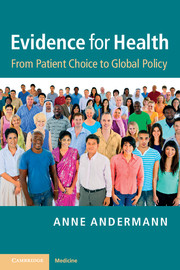Book contents
- Frontmatter
- Contents
- Foreword
- Preface
- Endorsements
- About the author
- Acknowledgments
- 1 Introduction
- 2 Strategies for improving health
- 3 Understanding how decisions influence health
- 4 Producing evidence to inform health decisions
- 5 Facilitators and barriers to using evidence
- 6 Making evidence-informed decisions
- 7 Conclusion
- Index
- References
3 - Understanding how decisions influence health
Published online by Cambridge University Press: 05 February 2013
- Frontmatter
- Contents
- Foreword
- Preface
- Endorsements
- About the author
- Acknowledgments
- 1 Introduction
- 2 Strategies for improving health
- 3 Understanding how decisions influence health
- 4 Producing evidence to inform health decisions
- 5 Facilitators and barriers to using evidence
- 6 Making evidence-informed decisions
- 7 Conclusion
- Index
- References
Summary
Decision-making for health is a complex matter. Some decisions are banal everyday choices that we make at the individual level – decisions that are often shaped by many extrinsic forces. Should I buy sweets or a fruit as a snack? Will I drive or cycle to work today? While each individual decision may have relatively little importance, taken together and multiplied across the entire population, the effects can add up. Nonetheless, we are generally very preoccupied with these small decisions, while large-scale decisions made at a population or global level seem entirely beyond our control and tend to go unnoticed, even though they may have even more profound effects on our collective health. For instance, certain countries are attempting to develop nuclear weapons, other countries have a laissez faire attitude towards the oversight of financial markets risking worldwide economic crises, and others still continue to produce and export harmful products ranging from asbestos to machine guns and cluster bombs, which could have devastating impacts on the health of large numbers of people worldwide. Who is regulating these decisions? How can we better inform these decisions using the best available evidence? The purpose of this chapter is to provide an overview of decision-making for health from patient choice to global policy as a first step towards better understanding how these decisions are made and how we can intervene to improve health.
Individual health decisions
We all make decisions about our health. Some decisions are rather quick and painless, and others are more important and thought through. Some decisions we make for ourselves, and others are for the health of loved ones. Some decisions, particularly those that deal with questions of life and death, we hope that we never have to face, and, if we do, we would want someone well informed and trustworthy to be there to guide us through it. Thus there are a range of different health decisions made at an individual level, and a wide array of factors that influence these decisions. To illustrate these, and to provide an introduction to the extensive but disparate literature on the subject, I will use three case examples.
- Type
- Chapter
- Information
- Evidence for HealthFrom Patient Choice to Global Policy, pp. 26 - 73Publisher: Cambridge University PressPrint publication year: 2012



